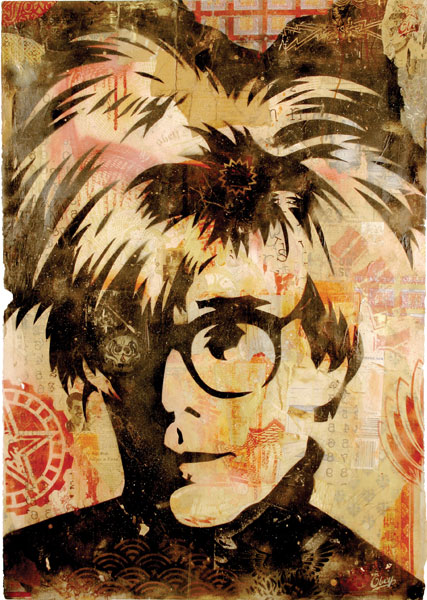Artist As Activist and Agitator
Shepard Fairey is suddenly everywhere – in the news, on walls, buildings and bridges, in museums, and, yes, in court. Fairey, 38, is the 1992 Rhode Island School of Design grad best known for his ubiquitous Obama Hope posters, but he has emerged in recent years as the new Andy Warhol, a most public artist […]

Obey Andy Warhol Stencil, 2004, Mixed media stencil collage on paper, 44 x 30 in., Courtesy of Obey Giant Art
Shepard Fairey is suddenly everywhere – in the news, on walls, buildings and bridges, in museums, and, yes, in court. Fairey, 38, is the 1992 Rhode Island School of Design grad best known for his ubiquitous Obama Hope posters, but he has emerged in recent years as the new Andy Warhol, a most public artist capable of provoking controversy wherever he goes.
Nominally a guerilla street artist given to plastering cities with stickers and posters, Fairey is actually a one-man art industry, blurring the distinction between fine art and commercial art by creating not only posters and prints but also stickers, stencils, CD covers, and t-shirts. His Obama image, in a peel-off advertisement, graces the cover of the February issue of Esquire. His Los Angeles-based Studio Number One design firm creates album covers for rock groups. And he markets a line of OBEY clothing. Talk about the tension between commerce and art; Shepard Fairey plays both ends against the middle.
The institutional occasion for calling attention to this art world phenom is Shepard Fairey: Supply and Demand, a 20-year retrospective of the artist’s multifaceted work at the Institute of Contemporary Art in Boston (through August 16), a must-see show for anyone remotely interested in the power of art to agitate and advocate. The Boston ICA show, sponsored by Levi Strauss & Co., features some 250 works, beginning with the Andre the Giant images Fairey first created as a RISD student. But it his appropriation of a photograph of Barack Obama to create the inspirational Obama Hope poster, a very Warholian graphic in off-color red, white, blue, that has Fairey in the news as much as his ICA show.
In a pre-emptive strike against the Associated Press, which claims to own the rights to the photograph Fairey used to create the Obama poster and charges copyright infringement, the Fair Use Project of the Stanford Law School Center for the Internet and Society has filed suit against the AP on Fairey’s behalf seeking a ruling that Fairey has the right to use the AP image in his art.
The Fair Use argument goes that Fairey used a photograph of Obama taken for the AP by photographer Mannie Garcia at the National Press Club in April of 2006 and that his sue of it is entirely different from the original and transform it from a literal depiction of Obama into an iconic artistic statement of support for the candidate, now President of the United States. The National Portrait Gallery has acquired the original mixed-media stencil collage for its collection.
On the one hand, the vagaries of copyright law not withstanding, it seems pretty clear that Fairey made use of another man’s work and, ethically, should have sought permission and perhaps paid for its use. In this multi-platformed digital age, photographers are preyed upon unmercifully all the time. On the other hand, I’d be more sympathetic to the Associated Press if it gave by-line credit to its photographers, which it typically does not. And the fact that photographer Mannie Garcia does not object to Fairey’s use of his photograph, which was cropped and altered to make the Obama Hope portrait, makes the artistic dispute mute as far as I’m concerned. Game, set, match, Fairey.
Of course, Fairey’s bad boy image was only enhanced on the eve of his ICA opening when he was arrested by Boston police on outstanding warrants for defacing property, namely a Massachusetts Turnpike Authority bridge and an electrical box where he had plastered his work years before. Though artists have no more inalienable right than vandals to deface public or private property, the arrest did nothing to enhance Boston’s reputation as a city ambivalent at best about art. You’d like to think the Boston Police Department has more pressing demands on its time. Between now and August, be sure to make time yourself to head down to the Boston waterfront for Supply and Demand, a nice survey of art by an artist who at once subverts and sustains American consumerism.
Institute of Contemporary Art, 100 Northern Ave., Boston, MA, 671-478-3100.
Edgar Allen Beem
Take a look at art in New England with Edgar Allen Beem. He’s been art critic for the Portland Independent, art critic and feature writer for Maine Times, and now is a freelance writer for Yankee, Down East, Boston Globe Magazine, The Forecaster, and Photo District News. He’s the author of Maine Art Now (1990) and Maine: The Spirit of America (2000).
More by Edgar Allen Beem

